CHINA – VATICAN
Fengxiang: Mgr Peter Li Huiyuan, former underground bishop, becomes official bishop
Mgr Li was already coadjutor bishop, recognised by the Holy See in 2017. Mgr Lucas Li Jingfeng had already prepared the “peaceful” transition from underground to official status. Provincial authorities are set to guarantee freedom. The Church is united in the diocese and across Shaanxi.
06/22/2020, 12.52



Fengxiang (AsiaNews) – Mgr Peter Li Huiyuan, unofficial bishop of Fengxiang (Shaanxi) since 2017, but recognised by the Holy See since 2015 as coadjutor bishop, became the official bishop, recognised by the government, in a ceremony in St Joseph cathedral.
Many bishops from Shaanxi attended the ceremony: Joseph Tong Changping of Weinan, Joseph Wu Qinjing of Zhouzhi, Joseph Han Yingjin of Sanyuan, Anthony Dang Mingyan of Xian, Stephen Xu Hongwei from Hanzhong, and John Baptist Yang Xiaoting of Yanan (pictured).
Due to regulations related to the pandemic, still active in Beijing and Xian, only 300 people were able to attend the service in the cathedral, along with several civil authorities.
The diocese of Fengxiang has about 20,000 members, 50 priests and 200 nuns. “Everything went very calmly and solemnly,” one of the faithful present said to AsiaNews.
Mgr Peter Li Huiyuan, 55, was coadjutor bishop of Mgr Lucas Li Jingfeng, who passed away in 2017. The latter never accepted to belong to the Chinese Patriotic Catholic Association.
With the official installation of the bishop, the diocese shifts from the underground Church to the official Church.
Contrary to what is taking place in the dioceses in Fujian, Zhejiang, Henan, Guangdong, Heilongjiang, where government authorities are very harsh with unofficial communities, the authorities in Shaanxi have long sought some harmony with the Church.
According to some local priests, the transition from “underground” to official status was undertaken with “serenity” thanks to a number of factors:
1. The process had already begun under Mgr Li Jingfeng, who was prepared to accept government recognition only on the condition that he not be required to break his bond with the Pope and that his communities be guaranteed religious freedom.
2. Shaanxi authorities, eager to settle the problem, gave these guarantees to Mgr Lucas Li and then to Mgr Peter Li.
Not long ago there was the problem of the demolition of a church in Qianyang. The authorities eventually apologised because they had to follow the new regulations on religious activities.
These provide for stringent safety standards for religious buildings, which the Qianyang church did not meet, and require that churches be built in places that are hidden or barely visible. The Qianyang church was built in a central location.
As a form of “apology” for the demolition, the authorities promised new land to build a new church, but in a more peripheral location.
3. Already back in the days of Mgr Lucas Li, all the priests of Fengxiang agreed not to be divided. There is also great unity with all the other dioceses of Shaanxi, which facilitates relations with provincial authorities.
The new bishop “is a man of faith, honest, sincere. He is a bit shy, but he is highly respected by everyone.”
To go from underground to official status, it was necessary to follow the “democratic” method imposed on the official Chinese Church, namely that a candidate be elected in a vote by a diocesan committee: Mgr Peter Li received a unanimous vote.


 ENG
ENG